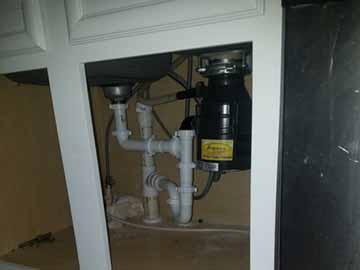
A continuous feed garbage disposal is what most kitchens have these days. Once you flip the switch to turn it on, it runs continuously. Once you are done then you simply flip the switch again to turn it off.
Just make sure to have your water running while you’re using it.
It grinds the food items that you put down the drain. If you have a dishwasher installed then it will also automatically pump water out of your sink so dishes can be washed with fresh and clean water every time!
This is not just for convenience either; this system actually saves energy by cutting back on the amount of water and energy that is wasted during pauses.
What Are The Different Types Of Garbage Disposals?
There are two main types of garbage disposals.
- Continuous Feed
- Batch Feed
We’ve already discussed what a continuous feed disposal is and how it’s used so let’s go over what a batch feed disposal is.
You know that the continous feed simply keeps running once you turn it on because it’s connected to an electrical outlet. Well, a batch feed garbage disposal does not use electricity. It only runs when you place the top that it comes with into the sink drain. So the idea is that you put your food items into the drain / garbage disposal and then place the lid on it and that will activate it to run and do it’s job of grinding the items you put in there.
What Are The Pros and Cons Of These Two Garbage Disposal?
Let’s go over some of the benefits and downsides of each of these types of garbage disposals. Knowing this information can help you to make a better decision as to which one you may want to install in your home.
Continuous Feed Garbage Disposal Pros and Cons
Pro – There’s no denying that a continuous feed disposal can be super fast. After all, they have a powerful motor that works it’s magic on grinding up the food you put in the unit.
Pro – It can be affordable. There are a wide range of types of continuous feed units so the cost can vary greatly but generally they are very affordable. The main expense would come in if you are installing one where there was none and you need to pay an electrician to wire the unit to your home’s existing electrical grid.
Con – It can be a dangerous appliance in your kitchen. Especially if you have small children or there’s someone in the home who has Alzheimer’s or dementia. If they put their hand in the unit while it’s running they can suffer severe injuries.
Con – Because the mouth of continuous feed units are open, it’s very easy for items to get knocked in there by a person or the family pet. It’s also very easy for food to spit out when you turn it on so stand back!
Batch Feed Garbage Disposal Pros and Cons
Pro – They tend to be safer since they only run when the cover is placed over them. This also means that you cannot put your hand into your drain, food debris won’t come flying out and less chance of your cat pushing a utensil into the garbage disposal!
Pro – Works best for sinks that have no access to electricity which is true for many island sinks.
Pro – It’s easier to install because there’s no need for an electrician.
Pro – Batch feed garbage disposals are quieter than continuous feed models.
Pro – They work very well.
Con – Batch feed modesl are generally more expensive than continuous feed disposals.
Con – It can take longer to grind the items that need to be grinded so if you’re making a large meal you may end up spending several more minutes on this task.
Con – You have to be careful not to lose or damage the cover to the batch feed disposal because it can’t work without it. Replacing that cover can cost up to $40.00.
Con – The idea with a batch feed disposal is that you put all the food you need to grind in it at once and then use the topper. And although this seems like it could save you some time, it may actually end up creating a clog. This is especially true if your home has older pipes.
Con – Batch feed disposals are usually larger than their counterparts so expect to sacrifice some more under sink space to accommodate them.
How Do You Know What Kind Of Garbage Disposal You Need?
The type of garbage disposal that you choose, batch feed or continuous feed really boils down to the location where you are installing the garbage disposal. And the main determining factor is the availability of electricity to that location.
So, if the sink that you want to install the unit in has no access to electricity and it’s either too expensive ot there is no way to get electricity to that area then you will have to go with a batch feed garbage disposal.
If you are concerned about the safety issue, for whatever reason, then we would recommend a batch feed unit as well.
Cheatsheet Of What NOT To Put Down Your Garbage Disposal
No matter what type of garbage disposal you choose – the list of items that you should NOT put down that unit is the same.
Artichokes
Asparagus
Banana
Peels
Barley
Beans
Bones
Carrots
Celery
Coconuts
Coffee Grounds
Corn Husks
Couscous
Cucumber Peels
Eggshells
Flour of any kind
Grease and Fats
Grits
Lettuce
Meats
Millet
Oatmeal
Onion Skins
Pasta
Pineapple Rinds
Pits and Seeds
Popcorn (popped or unpopped)
Potato Peels
Quinoa
Rice
Sweet Potatoes
Watermelon Rinds
If you have any questions about garbage disposal or are having some problems with it, call Atlantis Plumbing today at 770-505-8570. We are available 24 hours a day, 7 days a week.